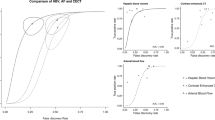Abstract
IN the course of studying the role of circulatory changes in the pathogenesis of centrilobular hepatic lesions1,2, we have been attempting by various techniques, including the use of neoprene latex and indian ink3, to clarify certain controversial points in the normal liver circulation.
This is a preview of subscription content, access via your institution
Access options
Subscribe to this journal
Receive 51 print issues and online access
$199.00 per year
only $3.90 per issue
Buy this article
- Purchase on Springer Link
- Instant access to full article PDF
Prices may be subject to local taxes which are calculated during checkout
Similar content being viewed by others
References
Maegraith, B. G., and Findlay, G. M., Lancet, ii, 403 (1944).
Maegraith, B. G., Andrews, W. H. Horner, and Gall, D., Lancet, ii, 781 (1947).
Andrews, W. H. Horner, and Maegraith, B. G., Ann. Trop. Med. and Parasit., 42, 95 (1948).
Mall, F. P., Amer. J. Anat., 5, 227 (1906).
Author information
Authors and Affiliations
Rights and permissions
About this article
Cite this article
ANDREWS, W., MAEGRAITH, B. & WENYON, C. Micro-Anatomy of the Hepatic Circulation. Nature 164, 1011–1012 (1949). https://doi.org/10.1038/1641011b0
Issue Date:
DOI: https://doi.org/10.1038/1641011b0
Comments
By submitting a comment you agree to abide by our Terms and Community Guidelines. If you find something abusive or that does not comply with our terms or guidelines please flag it as inappropriate.



